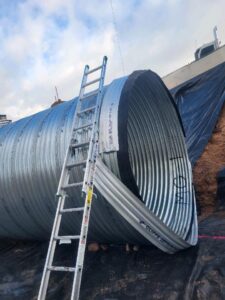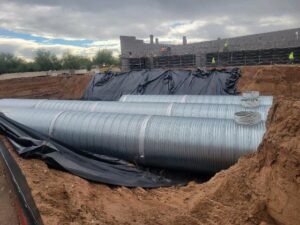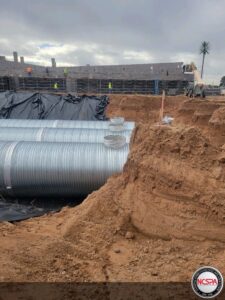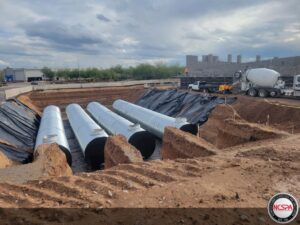By: Pacific Corrugated Pipe Co.

This project consisted of several runs of piping in varying diameters to complete a large detention system for a new car wash in Arizona. There was some urgency on this project which was originally designed using several 120″ diameter tees and elbows to connect each barrel. While the design was familiar, it’s particulars do present some challenges for production and for the installing contractor. These large diameter fittings require an extensive labor allocation to fabricate. Further, their handling and installation are much more challenging to an installing contractor than smaller diameter fittings.

So, given the familiarity of the design challenges and the requested delivery date, Pacific Corrugated Pipe Company (PCPC) created a resigned option. This new detention system option would not only assist in driving down the total cost but also simplified the installation. Further, this new design would eliminate the large 120” fittings in favor of a smaller 18″ diameter manifold system. The redesign required that 12 end caps be welded onto the ends of most runs and added the manifold system to allow flow between each run. This new design would not only decrease the amount of time Pacific Corrugated Pipe needed to fabricate the system but would also save the contractor both time and money on installation.
This new detention system design would require engineering approval so PCPC outlined all the specific changes for the contractor to review. The new design was quickly approved by the engineers and the process to fabricate began. The approved design required almost 700 feet of 120” 14 gage galvanized pipe as well as 12-48″ risers and smaller diameter manifold equalization pipe. The final piece of the puzzle were the bands required to assemble the system. Since the contractor preferred working with galvanized material, a benign envelope was recommended to meet the life-cycle requirements. This process included filter fabric and crushed rock to complete the envelope.

I n the end, the contractor was able to save days of installation time and ultimately delivered a system that matched the flow and containment requirements of the original design. It’s great when a new plan comes together so well for all involved parties.
n the end, the contractor was able to save days of installation time and ultimately delivered a system that matched the flow and containment requirements of the original design. It’s great when a new plan comes together so well for all involved parties.